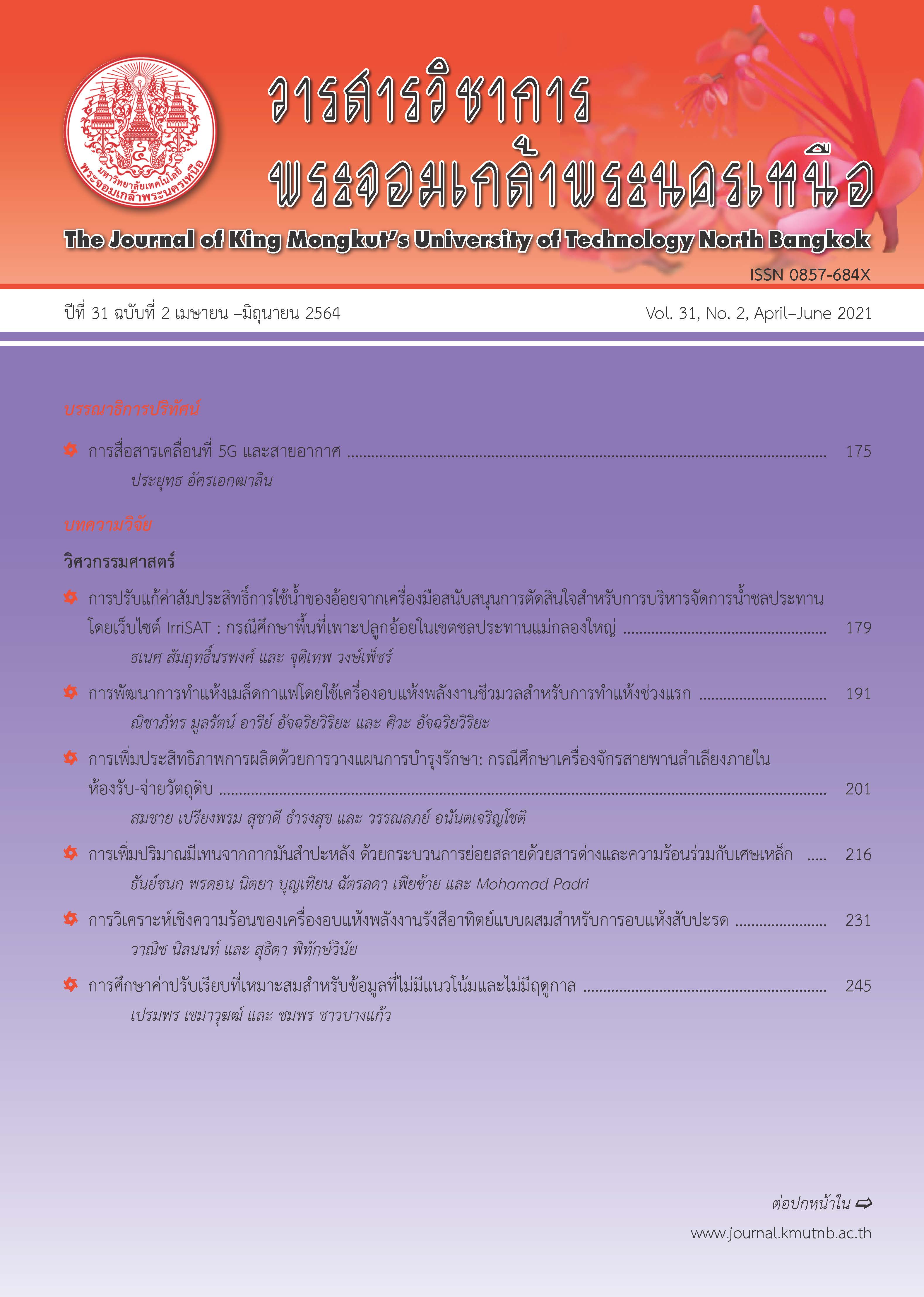การปรับแก้ค่าสัมประสิทธิ์การใช้น้ำของอ้อยจากเครื่องมือสนับสนุนการตัดสินใจสำหรับการบริหารจัดการน้ำชลประทานโดยเว็บไซต์ IrriSAT : กรณีศึกษาพื้นที่เพาะปลูกอ้อยในเขตชลประทานแม่กลองใหญ่
Main Article Content
บทคัดย่อ
เครื่องมือสนับสนุนการตัดสินใจสำหรับการบริหารจัดการน้ำชลประทานซึ่งให้บริการผ่านเว็บไซต์ IrriSAT สามารถประมาณค่าสัมประสิทธิ์การใช้น้้ำของพืช (Kc) จากการประเมินค่าดัชนีพืชพรรณ (Normalized Difference Vegetation Index; NDVI) ผ่านกระบวนการแปลภาพถ่ายดาวเทียม โดยงานวิจัยนี้มีวัตถุประสงค์ เพื่อพัฒนาแนวทางสมการปรับแก้ค่าสัมประสิทธิ์การใช้พืชจาก IrriSAT เพื่อให้สอดคล้องกับค่าสัมประสิทธิ์การใช้น้ำของอ้อยในพื้นที่โครงการชลประทานแม่กลองใหญ่ซึ่งเป็นขั้นตอนแรกในการประยุกต์ใช้แบบจำลองกำหนดการให้น้ำอ้อย (Sugar Cane Irrigation Scheduling Model; SCIS Model) สำหรับคำนวณกำหนดการให้น้ำอ้อยในพื้นที่โครงการชลประทานแม่กลองใหญ่ จากการสอบเทียบและทวนสอบดำเนินการในแปลงเพาะปลูกที่ทราบปฏิทินเพาะปลูกจริง มีอายุของอ้อยและปฏิทินเพาะปลูกที่แตกต่างกัน จากผลการศึกษาพบว่า สมการที่ใช้สำหรับการปรับแก้ค่าสัมประสิทธิ์การใช้น้ำของอ้อยในพื้นที่การศึกษา (Kc_Adj.) คือ Kc_Adj. = 1.4847Kc_IrriSAT การตรวจพิสูจน์ความแม่นยำของสมการปรับแก้พบว่า ค่าสัมประสิทธิ์การใช้น้ำของอ้อยหลังการปรับแก้มีความน่าเชื่อถือสูง จากการประเมินจากค่าความสัมพันธ์ทางสถิติซึ่งประกอบด้วย สัมประสิทธิ์การตัดสินใจ (R2) ความแม่นยำของการคาดคะเน (NSE) รากที่สองของค่าเฉลี่ยความผิดพลาดกำลังสอง (RMSE) ค่าความคลาดเคลื่อนสัมพันธ์เฉลี่ย (ARE) และร้อยละความเอนเอียงของการประมาณ (PBIAS) โดยมีค่าความสัมพันธ์ทางสถิติสำหรับแปลงเพาะปลูกที่ใช้ในการสอบเทียบเท่ากับ 0.92, 0.91, 0.11, 14.54, 0.61 ตามลำดับ และสำหรับการทวนสอบเท่ากับ 0.91, 0.89, 0.12, 36.90, 7.09 ตามลำดับ ดังนั้น สมการปรับแก้ค่าสัมประสิทธิ์การใช้น้ำของอ้อยจากเทคโนโลยีภาพถ่ายดาวเทียมที่มีความแม่นยำสูง และช่วยอำนวยความสะดวกในการคำนวณกำหนดการให้น้ำ ปริมาณน้ำที่ต้องการในพื้นที่เพาะปลูกภายในโครงการชลประทานแม่กลองใหญ่
Article Details
บทความที่ลงตีพิมพ์เป็นข้อคิดเห็นของผู้เขียนเท่านั้น
ผู้เขียนจะต้องเป็นผู้รับผิดชอบต่อผลทางกฎหมายใดๆ ที่อาจเกิดขึ้นจากบทความนั้น
เอกสารอ้างอิง
[2] X. Qin, F. Glenn, M. K. Dan, and P. Gary, “A theoretical economic model of the demand for irrigation water,” Agricultural Water Management, vol. 225, 2019.
[3] T. Garnett, M. C. Appleby, A. Balmford, I. J. Bateman, T. G. Benton, P. Bloomer, B. Burlingame, M. Dawkins, L. Dolan, D. Fraser, M. Herrero, I. Hoffmann, P. Smith, P. K. Thornton, C. Toulmin, S. J. Vermeulen, and H. C. J. Godfray, “Sustainable intensification in agriculture: Premises and policies,” Science, vol. 341, pp. 33–34, 2013.
[4] S. Koontanakulvong, P. Doungmanee, and P. Ruangrassamee, “The concept of water resources security - Thailand and the international,” Faculty of Engineering, Chulalongkorn University, 2013 (in Thai).
[5] Ministry of Industry, The Ministry of Industry’s Strategic Plan 2017 – 2021. Ministry of Industry, Bankok, 2016 (in Thai).
[6] Royal Irrigation Department, Water Allocation and Cultivation Plans 2016. Royal Irrigation Department, Bangkok, 2015 (in Thai).
[7] C. Alfonso, C. Isidro O. Anna D. Guido, and M. Massimo, “Remote sensing for crop water management: From ET modelling to services for the end users,” Sensors, vol. 17, no. 5, pp. 1104–1129, 2017.
[8] A. R. Formaggio and I. del A. Sanches, Sensoriamento Remoto em Agricultura. São Paulo: Oficina de Textos, 2017.
[9] P. Laotrakul. (2015, November). Visual Interpretation. GISTDA, Thailand [Online]. Available: https://www.gistda.or.th/main/th/node/997
[10] T. Samritnorapong, J. Vongphet, R. Yoosamran, and P. Sopaphun, “Development of sugar cane irrigation schedule model,” in Proceedings TSAE Conference, 2018, vol.19, pp. 350–356.
[11] E. Kositsakulchai, Crop Evapotranspiration Theory and Applications. Nakhon Pathom: Kasetsart Textbook Publishing Center, 2014 (in Thai).
[12] R. G. Allen, L. S. Pereira, D. Raes, and M. Smith, Crop evapotranspiration: Guidelines for computing crop water requirements – FAO Irrigation and Drainage Paper 56. Rome, Italy: United Nations FAO, 1998.
[13] C. Tucker, “Red and photographic infrared linear combinations for monitoring vegetation,” Remote Sensing of Environment, vol. 8, no. 2, pp. 127–150, 1979.
[14] Z. Li and D. Tan. “A modified perpendicular drought index in NIR Red reflectance space,” in Proceedings IOP Conference Series Earth and Environmental Science, 2014, pp. 1–6.
[15] T. J. Trout and L. F. Johnson. “Estimating crop water use from remotely sensed NDVI, Crop Models and Reference ET,” in Proceedings USCID Fourth International Conference, 2007, pp. 275–285.
[16] J. Hornbuckle, J. Vleeshouwer, C. Ballester, J. Montgomery, R. Hoogers, and R. Bridgart. “IrriSAT technical reference,” in Proceedings Irrigation Australia International Conference, 2016, pp. 1–17.

